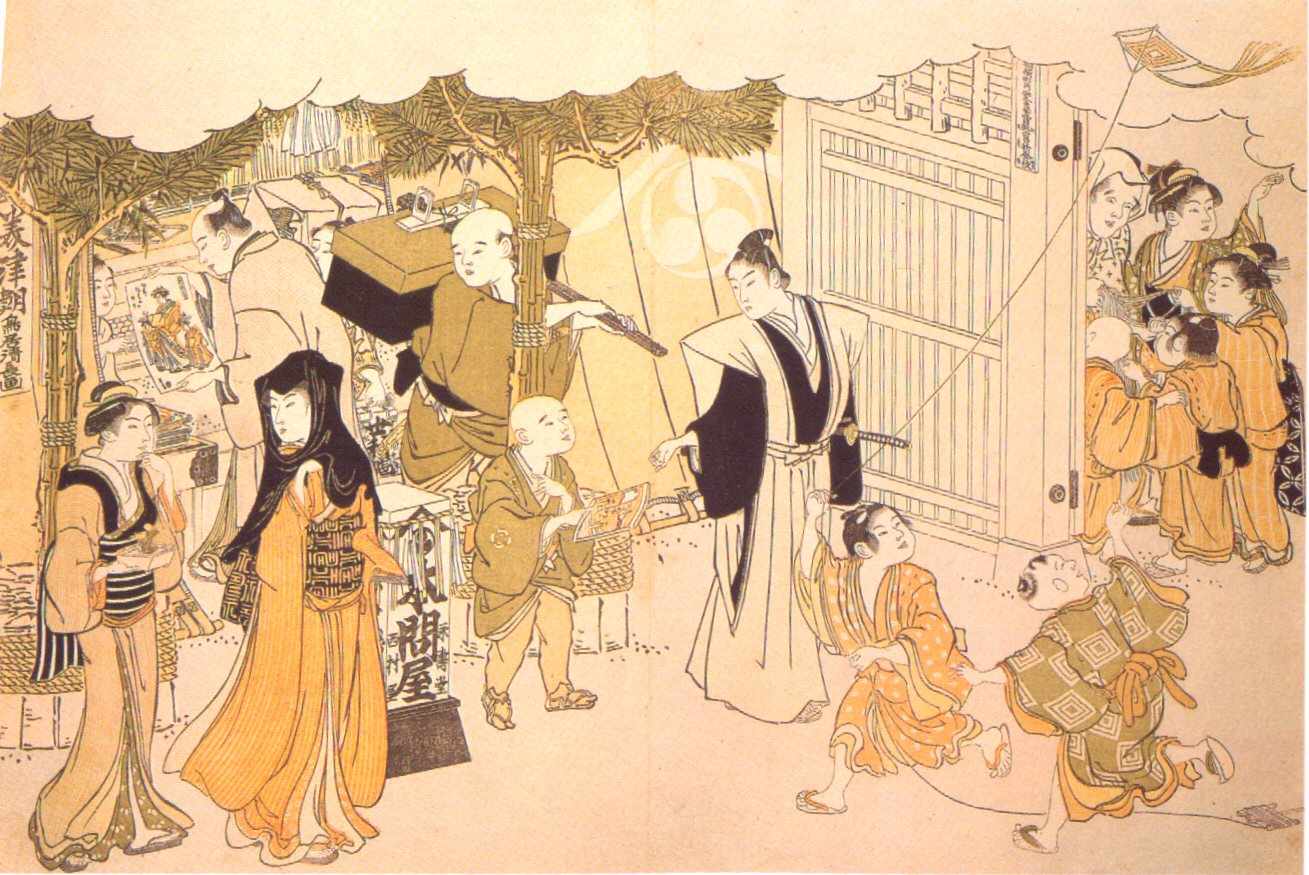According to Imamura on page 76 of “Family Culture,” “few [societies] are as consciously aware of family systems” as Japan’s. The postwar family continues to be shaped by the prewar ie system in regards to its organization, ideological underpinnings, and relationships between members. However, economically-driven developments and a growing acceptance of alternative lifestyles are changing the Japanese family in unique ways while reflecting changes in Japanese society itself.
The Japanese ie (household unit), codified in the Meiji period, forms the basis for the modern family system. Traditionally, a male head managed household finances and members while his shufu (wife) managed domestic resources. These were not always separate responsibilities; agricultural and small business households relied on housewives to contribute to income-generating activities (Imamura, “Family Culture” 80). The ie was sustained by the practice of primogeniture by which the eldest son would inherit the household with the expectation of caring for the parents. Younger sons would form subordinate branch houses which continued to support the main branch. During the postwar period, rural, extended families have given way to urban, nuclear families as Japan has industrialized. The declining birthrate, which forced a drop in family size from 5 in 1955 to 2.55 in 2000, was a contributing factor (Sugimoto 83). Nuclear families, however, do not represent a majority of households and retain many characteristics of extended families; neighborhood groups have replaced kin as a source of communal assistance. Households outside of the conventional family structure are growing; single households now constitute one-quarter of Japanese households, reflecting a generation more accepting of lifetime singles and single mothers. (Sugimoto 186).
The Japanese household is founded upon such principles as cross-generational continuity, rank consciousness, and harmony via group orientation (Imamura, “Family Culture” 77). Each household represents a distinct, isolated unit; within the household, privacy is minimized and families are expected to function as a unit. This organization is a manifestation of the interplay between uchi (inner group) and soto (outer group) which produces a gap between family members and outsiders in Japanese society (Fukue 72). There is an emphasis on avoiding personal confrontation to maintain personal relationships and put the needs of the household above the needs of the individual. The koseki (family registry) is the cornerstone of Japanese family organization as a repository of information on family members, past and present. While once reinforced by the need for the ie to function as an ongoing economic entity, group orientation is maintained by family registries as “invisible, but highly effective, [ways] of maintaining patriarchal order” (Mouer 125); any deviant behavior could result in consequences for all family members. This characteristic helps explain the persistence of ie characteristics via the concept of seki: “unless one formally... [belongs] to an organization... one has no proper station in society” (Sugimoto 162).
The emergence in the 1960s of the sarariman (salaryman) significantly contributed to modern conceptions of gender-based divisions of labor in the household (Imamura, “Families as Mirrors” 43). Both men and women were constrained from engaging in activities which didn’t directly support the household. Long office hours often created a divide between a salaryman and his wife and children, partially remedied with the rise of the “new family” in the 1970s. This divide has sometimes resulted in exhaustion-induced domestic violence, representing “injuries... Japan’s corporate system has inflicted upon Japanese families” (Sugimoto 179). However, salarymen have never represented a majority in Japan. In 2006, 60.9% of Japanese establishments had 1-4 employees and professional white-collared workers made up only 29.9% of the labor force in 2005 (see Tables 4.1 and 2.4). The salaryman with a reliable income is instead an ideal representing “a coming of age as an adult member of society” (Mouer 120). Additionally, more Japanese are losing faith in the ideal as “new inequalities in income, wealth, and education” have become pronounced, evidenced by the rise of freelance workers, otaku (individuals with obsessive interests), and NEETs. As women gain earning power, Japanese salarymen are becoming harder pressed to sway potential mates as well, producing such phenomena as foreign marriage brokering for rural Japanese men.
The institution of marriage in Japan, while changing, remains a reflection of ie ideology. Traditionally, marriage was the product of family-arranged introductions known as omiai. The concept of “love marriages,” introduced in the 1970s, has become more popular and such marriages now make up 93.8% of marriages in Japan (Sugimoto 180). Similarly, Japan’s divorce rate has increased since the 1960s but remains “among the lowest recorded in industrially advanced nations” (Sugimoto 160). For decades in the postwar period, ie ideology has served as a deterrent for divorce. Even with the new Civil Code which espouses gender equality, many housewives, dependent on male-generated income and fearful of the consequences of social stigmatization, lack the means to successfully seek divorce. These difficulties have given rise to katei-nai rikon (divorce within marriage) and the rejection of love as an essential component of married life. While the Equal Employment Opportunity Law of 1986 and the casualization of labor have increased economic opportunities for women, many remain restrained by marriage, evidenced by Japan’s M-shaped curve for female labor participation which demonstrates consistent exit and reentry into the labor market (see Figure 6.2). As a result, since the 1980s, many women have been delaying marriage, having less children, or entering into a growing “housewife part-time labor market” (Sugimoto 165).
“Japan’s modernization has been carried out not by changing the ie principle but by utilizing it” (Fukue 73). The modern postwar family in Japan continues to reflect ie ideology in its basic form, which has retained gender-based divisions of labor and a dedication to the preservation of the household. However, certain changes “directly connected to economic growth,” such as new lifestyles, decreasing job security, and a growing female labor force, will continue to contribute to the growing diversification of the Japanese family system (Imamura, “Family Culture” 80).










 8:54 PM
8:54 PM
 NoelVermillion
NoelVermillion











